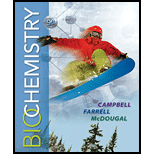
Concept explainers
RECALL What features distinguish enzymes that undergo allosteric control from those that obey the Michaelis–Menten equation?
Interpretation:
The difference between the enzymes that undergo allosteric control and the ones that obey the Michaelis–Menten equation is to be discussed.
Concept introduction:
The allosteric enzymes have multiple sites called allosteric sites. These enzymes change their shape when they bind to the substrate.
The binding of a molecule other than that of the substrate molecule can cause hindrance in the activity of the enzyme.
Answer to Problem 1RE
Solution:
The allosteric enzymes have multiple subunits and allosteric sites, whereas the Michaelis–Menten enzymes have a single active site, so there is a difference between the activities of these two enzymes. The rate of the concentration and substrate concentration graph for the allosteric enzyme is sigmoidal, while for the Michaelis–Menten enzyme, it is hyperbolic.
Explanation of Solution
The differences between the enzyme that undergo allosteric control and the ones that follow Michaelis–Menten equation are given in the table below:
| Allosteric enzyme | Michaelis-Menten enzyme |
| The allosteric enzymes have a number of allosteric sites or active sites. | These enzymes have a single active site to which a particular substrate can bind. |
| The multiple sites show the property of cooperativity, which means the binding of one molecule facilitates the binding of another molecule. | The substrate binds to the active site of the enzyme and leads to the formation of products. |
| The allosteric enzymes exist in two states: R-state and T-state. | The enzymes exist in a single native form only. |
| These enzymes show sigmoidal curve in the graph of reaction rate versus substrate concentration. | The enzymes show hyperbolic curve in the rate of the reaction versus substrate concentration graph. |
Hence, it can be concluded that the allosteric enzymes are unique as compared to the other enzymes because of their capability of adaptation to various conditions in the environment and are much different from the enzymes that follow Michaelis–Menten equation.
Want to see more full solutions like this?
Chapter 7 Solutions
Biochemistry
- write the ionization equilibrium for cysteine and calculate the piarrow_forwardplease answerarrow_forwardf. The genetic code is given below, along with a short strand of template DNA. Write the protein segment that would form from this DNA. 5'-A-T-G-G-C-T-A-G-G-T-A-A-C-C-T-G-C-A-T-T-A-G-3' Table 4.5 The genetic code First Position Second Position (5' end) U C A G Third Position (3' end) Phe Ser Tyr Cys U Phe Ser Tyr Cys Leu Ser Stop Stop Leu Ser Stop Trp UCAG Leu Pro His Arg His Arg C Leu Pro Gln Arg Pro Leu Gin Arg Pro Leu Ser Asn Thr lle Ser Asn Thr lle Arg A Thr Lys UCAG UCAC G lle Arg Thr Lys Met Gly Asp Ala Val Gly Asp Ala Val Gly G Glu Ala UCAC Val Gly Glu Ala Val Note: This table identifies the amino acid encoded by each triplet. For example, the codon 5'-AUG-3' on mRNA specifies methionine, whereas CAU specifies histidine. UAA, UAG, and UGA are termination signals. AUG is part of the initiation signal, in addition to coding for internal methionine residues. Table 4.5 Biochemistry, Seventh Edition 2012 W. H. Freeman and Company B eviation: does it play abbreviation:arrow_forward
- Answer all of the questions please draw structures for major productarrow_forwardfor glycolysis and the citric acid cycle below, show where ATP, NADH and FADH are used or formed. Show on the diagram the points where at least three other metabolic pathways intersect with these two.arrow_forwardanswer the questions please all of them should be answeredarrow_forward
- Burk plot is shown below. Calculate Km and max for this enzyme. show workarrow_forwardInsert Format Tools Extensions Help Normal text ▾ Arial C 2 10 3 + BIUA Student Guide (continued) Record data and conclusions about the mystery food sample either below or in a lab notebook. Step 2: Protein Test (Biuret Solution) Gelatin Water [Mystery Food (Positive Control) (Negative Control) Sample pink purple no change no change They mystery food sample does not contain protein because the color of the test tube wasn't pink or purple Color Conclusion They mystery food sample does not contain protein because the color of the test tube wasn't pink or purple Step 3: Lipid Test (Sudan Red Solution) Vegetable Oil Water (Positive Control) (Negative Control) Mystery Food Sample floating red no change floating red the mystery food dosnt contain lipids because the test tube has floating red 75 % 87 8 9 7 ChromeOS C Device will pow 26.battery lea powerarrow_forwardThe rate data from an enzyme catalyzed reaction with and without an inhibitor present is found in the image. Question: what is the KM and Vm and the nature of inhibitionarrow_forward
- 1. Estimate the concentration of an enzyme within a living cell. Assume that: (a): fresh tissue is 80% water and all of it is intracellular (b): the total soluble protein represents 15% of the weight (c): all the soluble proteins are enzymes (d): the average molecular weight of the proteins is 150,000 (E): about 100 different enzymes are present please help I am lostarrow_forwardPlease helparrow_forwardThe following data were recorded for the enzyme catalyzed conversion of S -> P. Question: Estimate the Vmax and Km. What would be the rate at 2.5 and 5.0 x 10-5 M [S] ?arrow_forward
 BiochemistryBiochemistryISBN:9781305961135Author:Mary K. Campbell, Shawn O. Farrell, Owen M. McDougalPublisher:Cengage Learning
BiochemistryBiochemistryISBN:9781305961135Author:Mary K. Campbell, Shawn O. Farrell, Owen M. McDougalPublisher:Cengage Learning
